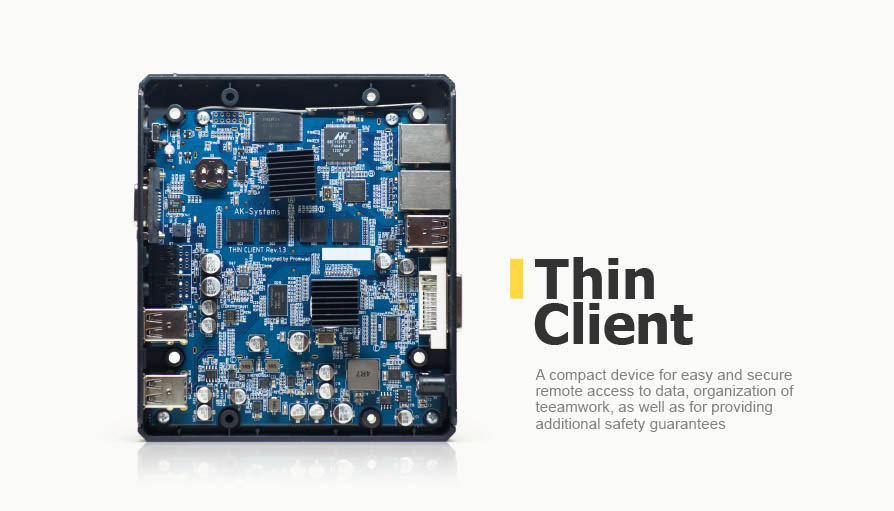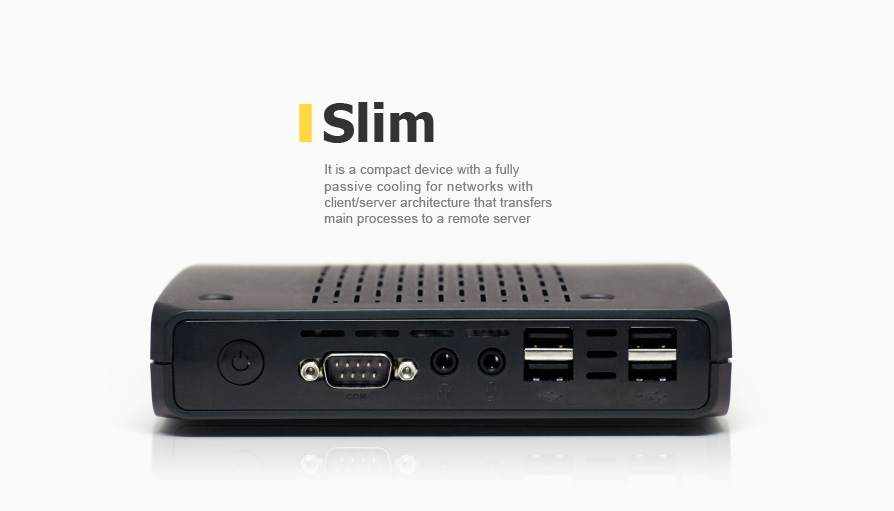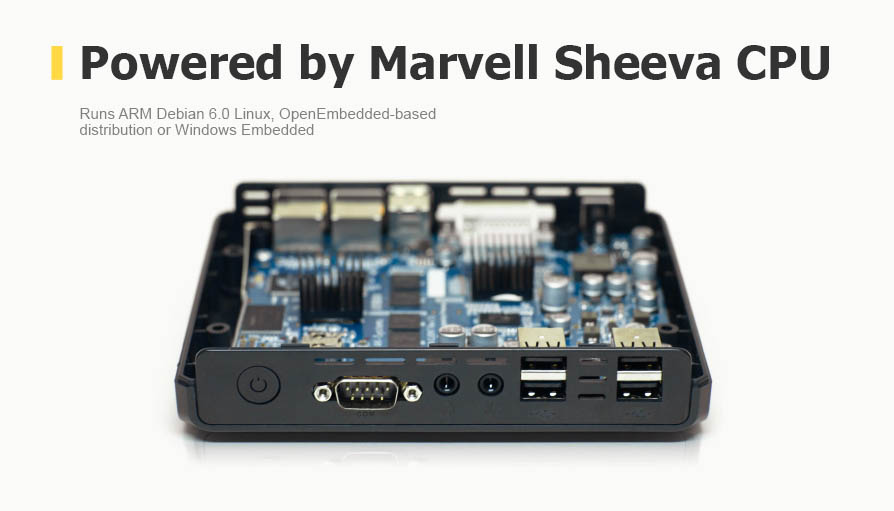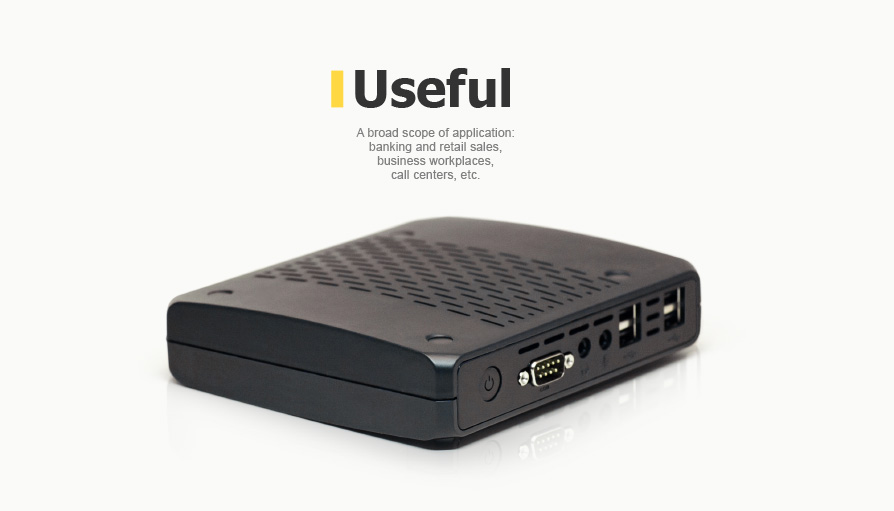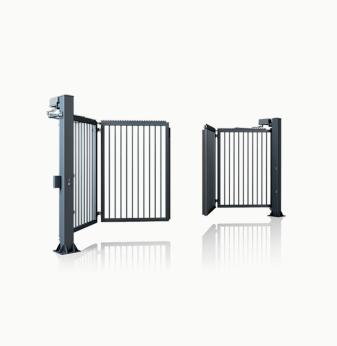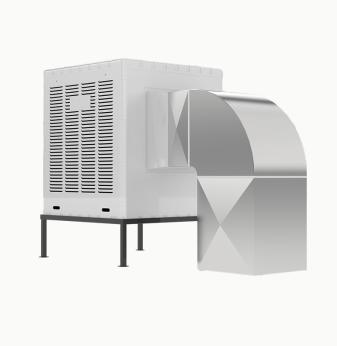Customer
A European manufacturer of telecom equipment that implements terminal and cloud technologies, supplies thin clients from different manufacturers, develops terminal stations and integrated solutions.
Objective
Development of a thin client, a computer for networks with a client-server architecture, which transfers the basic data processing operations to a remote server. The central tasks include:
- Selection of an elements base and development of a principal circuit
- PCB development and routing
- Enclosure design
- Development of a solid-state enclosure model
- Development of design documentation
- Selection and development of a graphic user interface
- Software development
- Installation and adjustment of prototypes
- Product certification
- Batch production launch
1. Software requirements
- Embedded operating system: Linux
- System loading time: up to 30 seconds
- Remote administration system: remote control, administration, monitoring, software installation and update, as well as batch work (involving a group of thin clients)
- Information security system agents and java keys
- Support for the drivers of local peripheral devices: monitors, printers, scanners and input devices
2. Hardware requirements
- Operating time to failure: not less than 5 years
- SPU frequency not less than 1.2 GHz
- RAM 500 MB/1 GB/2 GB; Flash 500 MB/4 GB /8 GB
- 10/100/1000 Ethernet
- 4хUSB: two ports on the front panel, four ports on the back panel (two of them for the keyboard and the mouse)
- 1хDVI; 1хCOM
- Headphones:1 port; microphone: 1 port
- Screen resolution: 1920х1200, 1920x1080, 1600х1200, 1680x1050, 1600x900, 1440x900…
- Allow optional installing of a WiFi module
3. Form-factor and power supply requirements
- Modern design, mat scratch-resistant surface
- Passive heatsink
- Monitor attachment included (VESA standard)
- Size range (long/wide/high): 120х31.5х160 mm
- Weight: not more than 800 gram
- External power source
Solution
After analyzing the existing manufacturers and their current base solutions, it was decided to develop a thin client based on the chips by Marvell. The company also produces additional chips to implement such solutions, which significantly reduces the overall manufacturing cost of the product. The company also provides maintenance and technical support at the product development stage.
The system is based on the Marvell 88F6282 processor. This processor is implemented using the Sheeva core, operating at frequencies of up to 2GHz. To connect the device to an Ethernet network, the processor has two MAC controllers (10/100/1000 Mbps), which are connected to the PHY 88E1121R, an external circuit by Marvell. This chip features two PHY circuits in one enclosure and a shared control channel, which significantly saves space on the board.
The processor has two PCI-e ports which are used in the system. The first port is brought to an internal mini PCI connector, to which additional external devices or Wi-Fi modules can be connected. The second port is used to connect a GPU device to implement a graphics subsystem.
The VOLARI-Z11 chip by SiS is used as a graphics controller (GPU). It has an integrated video DAC for analog video and a HDMI digital video interface. These signals are sent to the DVI connector which connects an external monitor with a maximum resolution of 1600x1200x32 @ 60NI. The operation of a graphics controller uses independent DDR2 memory with a maximum capacity of 128 MB.
The implementation of an audio subsystem uses the ALC5621 audio codec by Realtek. It has a microphone input, which is placed on the back panel, a linear stereo output, which is also located on the rear panel. To play audio messages, the system features a built-in speaker connected to the outputs of the power amplifier of the ALC5621 codec.
To connect external storage devices, the system uses four USB ports operating in the master mode. These ports use a HUB implemented on the USB2517 chip by SMSC. To connect devices with RS-232 support, the system uses a connector placed on the back panel.
DDR2 with a total capacity of 1 GB is used as program and data memory. NAND Flash 4GB is used for storing user data and software.
The system is powered by an external power supply which is plugged into a connector on the rear panel of the enclosure.
1. Design and structure
Four drafts of the product in various styles were created, according to the specified requirements. The process also involved the elaboration of the product’s design and ergonomics, as well as the development of the product’s structure and inner placement of the key elements.
Based on the selected draft, a solid-state 3D model of the product was created, after which a decision was made on the product design and mount fittings.
2. Software
Two software solutions are offered for the thin client: a full-featured operating system based on the ARM Debian 6.0 Linux distribution and a more compact custom distribution based on Open Embedded. Both distributions use the kernel version 2.6.39 and the Xfce window manager.
The thin client software includes the following terminal clients:
- Rdesktop, which is designed to support terminal Windows servers using the RDP protocol
- Citrix Receiver for Linux, which is designed to support Citrix terminal servers using the working ICA protocol
- VMware View Open Client, a client for supporting VMware terminal servers using the RDP protocol
Thin Client Control Center is an application used for administering thin client networks. It is designed to:
- Create, launch and change the parameters of various types of terminal sessions (RDP, Citrix, VMware)
- Edit and allocate access rights to terminal sessions
- Configure the thin client
- Receive information on the current status of the thin client
The software solution also includes applications with which the user can work directly on the thin client:
- Web browser: Firefox
- Multimedia players: vlc, mplayer, beepmp
- Linphone VoIP/SIP client
Benefits
- Virtually all PC functionality in a device with a compact form factor and completely passive cooling
- Can replace more expensive and bulky PCs; provides remote access and helps simultaneously work with data on the server; provides additional security warantees
- A broad scope of application: business workplaces, banking and retail sales, call centers, etc.
- Protection from information leaks: it uses information security system agents, java keys and a USB connector inside the enclosure for connecting security tokens
- Support for the drivers of peripherals
- Connecting an external monitor with a high resolution (max 1600x1200x32 @ 60NI)
- Connecting a microphone and headphones, a wide selection of embedded interfaces
- Wireless connection, the possibility of setting up an access point
- Ergonomic enclosure design, which provides operation without active cooling; scratch-resistant mat surface
- Compact form-factor (150x130x35 mm), small weight (up to 300 gram)
- Low manufacturing cost

